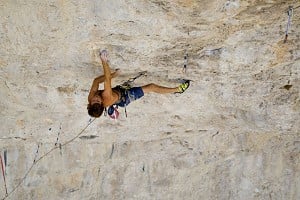

Boulder problems like The Mandala at Bishop, routes like Realization/Biographie at Ceuse, plus his more modern routes such as First Round First Minute at Margalef are not only desperately difficult, but they are beautiful and inspirational lines. King Lines you might say. And that is what Chris Sharma seems to be all about - travelling the world climbing the hardest projects, the best lines on the most perfect cliffs.
Really, I have no idea how to introduce Chris Sharma. He's a legend. He's really good at pinching tufas and hanging crimps. He's probably also pretty good on slopers too.
Here at UKC we thought it was about time we tracked him down and spoke to him about his climbing, about his life, and about the big projects that he has been working on, that may well push climbing standards up a notch even further.
"To climb harder than we ever have, we have to try harder than we have ever tried. If it feels easy then you probably need to be trying a harder route."
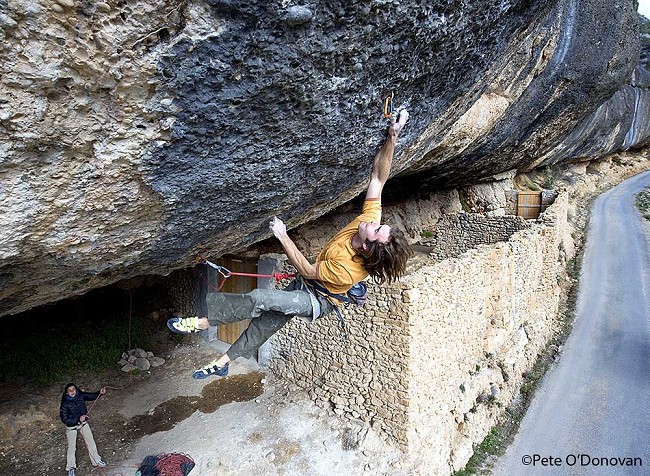
INTERVIEW: Chris Sharma
Jack: You started climbing at the age of 12 at the Pacific Edge climbing gym, and then went on to win the national championships two years later. Can you describe this stage in your climbing, and how you went from beginner to national champion in just two years? Did you start climbing with a vengeance? Training, and climbing hard, or were you just naturally talented?
Chris: It was a huge breakthrough in my life to discover climbing. Until then I was pretty mediocre at everything I tried. I fell deeply in love with it and used the money I earned from my paper route to buy my harness, shoes, a gym membership and from that point on I was in there every single day with a vengeance as you say and at the same time I guess I had quite a bit of natural talent. At that time I was really turned off by team sports and how competitive they were as well as how mean kids can be to each other at that age. Climbing is something that although competitive, is very personal and is more of a competition against yourself. Coming into the world of climbing it was really refreshing to meet so many down to earth people.
Jack: You seemed to then focus on hard sport climbing and bouldering for a few years, and this led to opening many of your own boulder problems and routes. Which ones stick out in your mind as memorable experiences, especially from earlier in your climbing career?
Chris: Definitely doing the first ascent of Necessary Evil (an 8c+ that Chris climbed in 1997) in the Virgin River Gorge was an important route, aside from that I was really motivated by the playfulness and simplicity of bouldering. Going to Hueco Tanks when I was 14 had a huge influence on me and it opened my eyes to hard steep climbing and meeting guys like Fred Nicole was super inspiring. Also climbing around my home area of Castle Rock I learned the joy and freedom of finding new boulders and doing things that were totally obscure but were personally really rewarding like the Eco Terrorist, the Hueco Wall, The Bates Eliminate sit start and all sorts of other random boulders in that forest.
I also spent quite a bit of time bouldering in Yosemite repeating all the Camp 4 classics. I had the privilege to climb there quite a bit with Ron Kauk. Another important place for me was the Buttermilks. I had been there only briefly when I was 12 years old, but when I came back 5 years later I was blown away by the place and in that time I had been around the world and had developed more my taste for finding new lines. I think it was a really special time when it was still pretty unknown. Climbs like The Buttermilker, and The Mandala obviously stand out but I also climbed a lot all over that area and put up a lot of new problems around Dales Camp. Most of the time I would go out by myself and wander the hillsides and let my imagination run wild. Around the same time I was taking trips to Ceuse to work on the amazing project Biographie. When I finally did it, it was a huge milestone in my climbing. So much of my climbing had always been so playful and that route really tested me to see how much I wanted it.
Jack: And more recently you seem to have changed focus from boulders to just routes, is this correct? If so, why is this?
Chris: After only bouldering for a handful of years, I needed to mix it up and keep things fresh and not get trapped by thinking I'm only a boulderer or only a sportclimber. Also having done some 8c boulders I started to feel that the room to push it much farther was much smaller. Holds can only get so small, and a lot of boulders were just getting longer as a way of adding more difficulty which in the end is more similar to route climbing.
It seems there is a point in all disciplines of climbing where the effort to go beyond your current level is so much that it comes into question whether its even worth it or not. For me climbing has always been more of an spontaneous, artistic, fun thing rather than a purely athletic endeavor (although it's really both), and it has always been important to not lose sight of. My re-inspiration for sport climbing really came from all the DWS I was doing in Mallorca. Psicobloc is such a perfect form of climbing. The freedom is similar to bouldering in that you can do a new FA on the fly yet the movement and length of the routes are more similar to sportclimbing. For me it's still the purest form of climbing, in that you can do whatever you want and there are no confines. So through DWS I was re-enamored by the continuous flow and rhythm and the amount of potential to find really challenging routes where you can stack hard boulder problems on top of each other one after the next and really test ones ability. At the same time I had taken a trip to Catalunya to climb with Dani Andrada and was super inspired by him and his unrelenting motivation to climb and develop new routes and areas. Where as in the past I had always climbed existing projects, seeing how much accessible rock and potential there is in Catalunya I really got inspired to re-dedicate myself to sportclimbing but through the perspective of bolting my own lines and this has given me the opportunity to really explore my vision for what's possible in a really creative and personal way.
Jack: Your current hardest routes seem to be around the 9b mark. This is at the edge of what is being climbed at the moment. Can you see yourself pushing this standard much further? And do you see others, perhaps Ondra, pushing this limit in the near future? If so, what changes, differences, variables need to fall in to place to make this happen?
Chris: Well, first of all I definitely see a lot of potential still to push the standards in sportclimbing. One of the biggest challenges is finding the perfect route that is just beyond our limits but that is also something much cooler and more inspiring to warrant trying harder and longer than ever before. In my time here living in Spain and dedicating myself to finding, developing and climbing the hardest routes 've been trying to find that next step. It seems instead of one giant leap it's a lot of baby steps instead. Although there are still no 9b+ routes, within the grade of 9b there are some easier and some harder. For example Neanderthal in Santa Linya might be on the lower end and First Round First Minute is probably nearer the higher end.
VIDEO: Chris Sharma climbing First Round First Minute - Margalef (9b)
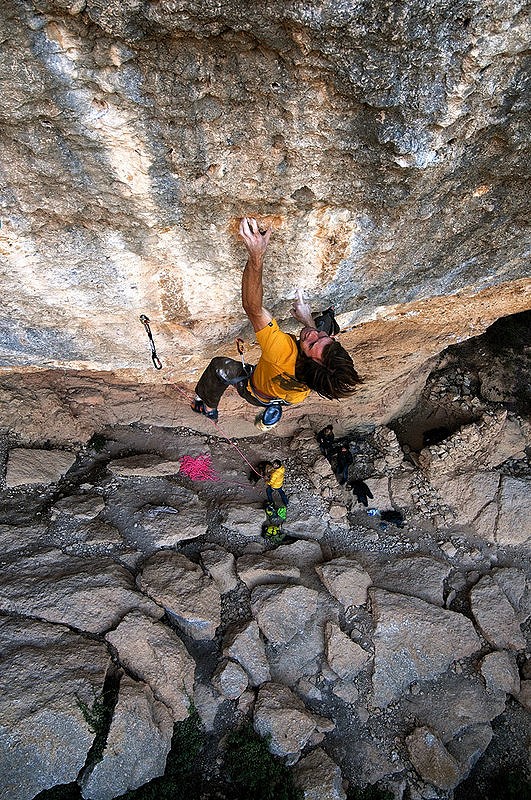
(TIP: Don't miss the video of Chris and Adam Ondra on the Dura Dura - at the base of this article)
I've been working on both of these lines on and off and have been quite close to redpointing several times. This last season I had the pleasure to work on La Dura Dura with Adam Ondra and it was an amazing experience to try such a hard line with such a good climber. We both had some really good goes but in the end the season came and went without a send. Although it may seem sometimes we walk away empty handed when we fail on our projects, I think redpointing isn't the only marker for progression. With La Dura Dura, I had thought that the route was totally beyond me and that it was a route for future generations. I had previously done all of the moves but was unable to link any of them. Teaming up with Adam, I think some of his motivation and determination rubbed off on me and I realised that maybe it was possible, and by the end of the season we were close to doing it. So even though I have nothing to show for all this time spent on that route I still feel like I had a huge progression in my climbing this year. So I think this year hopefully will be somewhat groundbreaking come November when the temperatures start getting good here in Catalunya.
Jack: In a recent video (we forget which one, maybe 'the Scene'!) you were working on a local multipitch limestone sport route project. Do you have many projects on the go - what is this one all about? And are you interested in doing more multipitch projects in the future?
Chris: I'm super psyched to continue evolving in my climbing and as I was saying it's really important to not get stuck limiting ourselves to one way or one style only.
In the same way I was motivated to apply my experience on the boulders to new hard routes I think there is a ton of potential to take what we've been doing in sportclimbing and take that to a bigger canvas. Right now I have two really amazing projects that I think really embody this concept. One is near our home in Catalunya and the other is in Mallorca. Really that is where I am most excited to take my climbing. After several days on these multipitch projects, I feel really excited for my projects in Oliana and Margalef and vice versa; when I'm a bit sick of falling off the same move over and over on my single pitch projects it's so good to get high up off the ground, disconnect and try something totally distinct. However I think it's really important to balance these big serious projects with the fun and playful side of climbing. On a recent trip back to Mallorca I was really blown away again by the psicobloc. Normally when I climb on a rope it's always very goal oriented and I only try my projects but with DWS climbing a 7b can be so exhilarating and satisfying. Growing up in Santa Cruz by the sea I've always had a really strong connection with the ocean and DWS brings these two worlds together.

Chris: I think its a really common dilemma for travelling climbers, where is the perfect place to live. After 10 years traveling constantly, my community of friends and family are spread out all over the world so there was no place where it was really clear to settle other than my hometown of Santa Cruz (where I have a lot of friends and family but no climbing). In the end however I dont think that perfect place really exists. I had been spending quite a bit of time over in Spain and was learning the language and discovering all of the amazing climbing over here, then I met my girlfriend Daila Ojeda and the feeling that I had for a while (that Spain is a place where I feel really good and that I could probably live there) kind of solidified and just started happening on its own. Living in one place is also the only real way to consistently have projects and develop new routes as these things take lots of time. So far it has been great living over here. There are definitely times when I miss calling up some of my buddies from Santa Cruz for an evening session at Castle Rock, and being so far away has its disadvantages, but in the end I've somehow found a really good balance with climbing and being in one place. Being here in Spain I've actually felt more connected to the international climbing community and we have so many friends that pass through that it seems like I see them more than before when I was never anywhere and couldn't make plans with anybody.
Jack: Day to day life for Chris Sharma, how does it all fit together? What work do you do, what climbing regime do you follow? What is the average week in the life of Chris Sharma?
Chris: Well I guess my life is kind of separated between the times I'm at home and the times I'm travelling.
Deciding to make my home here in Catalunya has meant that to maintain all my relationships and responsibilities I have to travel a lot. I usually travel back to the US about 4 times per year to do work for my sponsors etc. I would like to just go back to the US for a pure climbing trip but since I'm always gone for a while when I do go back I have all sorts of odds and ends to attend to.
When I'm back here in Spain, during the climbing season I usually climb 4 days a week. Sometimes more but I've found that sometimes less is better as the climbing season here is September through to June it's important to pace yourself. On my rest days I do a lot of correspondence with sponsors and I really really enjoy working around the house building things.
Jack: You have been climbing now for almost two decades. How has your outlook or focus on climbing changed from the early days, through to when you were putting up routes like Realization, through to the present day?
Chris: I guess a lot has changed but not so much at the same time. I'm just as motivated (if not more so) as before, focused on achieving my goals and doing my thing. It's great to see so many young talented climbers. It's kinda neat to see how the generations repeat themselves. When I started out I was in awe of all these older climbers and they were my inspiration. Now that maybe I'm one of the older climbers, I guess I'm inspiring the younger generation but what is interesting is how much the younger generation inspires me. It's easy to get lazy and complacent and seeing guys like Ondra so hungry for routes it totally reawakens the fire inside me as well. Sometimes we forget how hard we have to try. To climb harder than we ever have, we have to try harder than we have ever tried. If it feels easy then you probably need to be trying a harder route.
Jack: Thanks Chris - really great to talk to you, and really inspiring answers.
VIDEO: Chris Sharma vs Adam Ondra on the Dura Dura Project
Chris Sharma has several sponsors including: prAna, Sterling Rope, Petzl, Evolv, Entre-Prises, Sanuk.



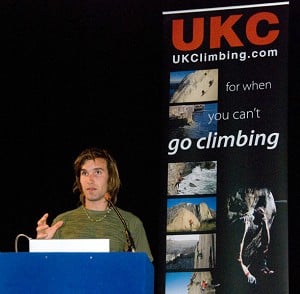
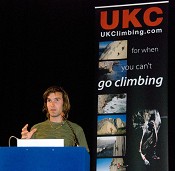








Comments